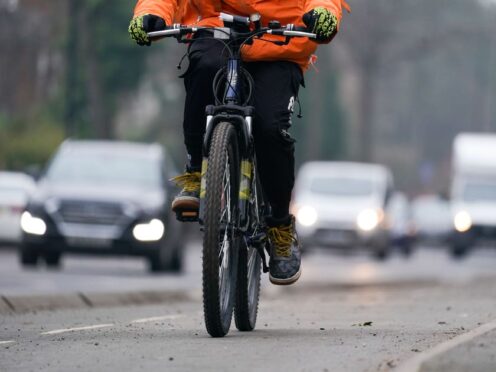Most people (56%) in urban areas would support shifting investment from road building to fund active travel and public transport, a new survey suggests.
The poll of 21,000 people commissioned by charity Sustrans indicated that just 17% would oppose such a move.
Half (50%) of respondents said they want to walk more, 43% want to do more cycling and 32% want to make greater use of public transport.
Just 15% said they want to drive more.
Active travel provides annual benefits worth £6.1 billion across 18 UK cities and prevents more than 21,000 serious long-term health conditions, according to Sustrans.
In addition, journeys walked, cycled or wheeled – such as by wheelchair – last year prevented 420,000 tonnes of greenhouse gas emissions entering the atmosphere, the charity calculated.
Sustrans chief executive Xavier Brice said: “The evidence shows that people want to have the choice to walk, cycle and use public transport.
“Moving forwards isn’t about forcing people out of their cars.
“It is about making it easy for people to travel how they would actually prefer to, which also improves public health, the economy and our environment.
“The UK is spending record sums on transport but the message from the public is clear – they want a real choice, they don’t want to be locked into driving a car because there are no other options.
“We’ve seen real improvement in the cities we’ve surveyed over the last 10 years, but there is a long way to go to make active travel work for everyone.
“Now the opportunity is for government at all levels to listen to what people want and shift future investment to options that benefit us all.”
The survey indicated that 65% of people would support banning pavement parking.
London is the only area in England where pavement parking is banned.
A Department for Transport (DfT) consultation on giving councils in the rest of the country the power to prohibit pavement parking ended in November 2020, but no announcement has been made.
The poll also suggested 58% of people would support more cycle paths being built alongside roads, with cyclists physically separated from traffic and pedestrians.
A DfT spokesperson said: “We’re committed to ensuring people can travel in the way that works best for them – whether that’s driving, using public transport or through walking, wheeling or cycling.
“Just days ago, we announced over £100 million for over 100km of new walking and cycling routes, improving access to our national parks, and e-cycle loan schemes – part of a projected £3 billion of funding by 2025, more than any previous Government has invested over one Parliament.”
– The Sustrans survey of 21,374 people living in 18 UK cities was conducted by research company NatCen between March and June last year.
